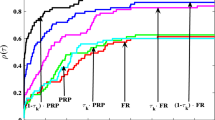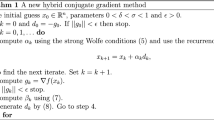Summary
The composite step biconjugate gradient method (CSBCG) is a simple modification of the standard biconjugate gradient algorithm (BCG) which smooths the sometimes erratic convergence of BCG by computing only a subset of the iterates. We show that 2×2 composite steps can cure breakdowns in the biconjugate gradient method caused by (near) singularity of principal submatrices of the tridiagonal matrix generated by the underlying Lanczos process. We also prove a “best approximation” result for the method. Some numerical illustrations showing the effect of roundoff error are given.
Similar content being viewed by others
References
Aziz, A.K., Babuška, I. (1972): Part I, survey lectures on the mathematical foundations of the finite element method. In: Aziz, A.K., ed., The Mathematical Foundations of the Finite Element Method with Applications to Partial Differential Equations, pp. 1–362. Academic Press, New York
Bank, R.E. (1990): PLTMG: a software package for solving elliptic partial differential equations, Users' Guide 6.0. Front. Appl. Math. SIAM, vol. 7
Bank, R.E., Bürgler, J.F., Fichtner, W., Smith, R.K. (1990): Some upwinding techniques for finite element approximations of convection-diffusion equations. Numer. Math.58, 185–202
Bank, R.E., Chan, T.F. (1992): A composite step bi-conjugate gradient algorithm for nonsymmetric linear systems. University of California, California
Bunch, J.R. (1974): Partial pivoting strategies for symmetric matrices. SIAM J. Numer. Anal.11, 521–528
Brezinski, C., Sadok, H. (1993): Lanczos-type algorithms for solving systems of linear equations. Appl. Num. Math.11, 443–473
Brezinski, C., Zaglia, M.R., Sadok, H. (1992): A breakdown-free Lanczos type algorithm for solving linear systems. Numer. Math.63, 29–38
Concus, P., Golub, G.H., O'Leary, D.P. (1976): A generalized conjugate gradient method for the numerical o solution of elliptic partial differential equations. In: J.R. Bunch, D.J. Rose, eds., Sparse matrix computations, p. 309–332. Academic Press, New York
Fletcher, R. (1976): Conjugate gradient methods for indefinite systems. In: G.A. Watson, ed., Numerical Analysis. Lecture Notes in Mathematics506, 73–89. Springer, Berlin Heidelberg New York
Freund, R.W. (1991): A transpose-free quasi-minimum residual algorithm for non-Hermitian linear systems. Tech. Rep. 91.18, RIACS. Nasa Ames Research Center, Moffett Field
Freund, R.W., Golub, G.H., Nachtigal, N.M. (1991): Iterative solution of linear systems. Tech. Rep. NA-91-05. Computer Science Department, Stanford University
Freund, R.W., Gutknecht, M.H., Nachtigal, N.M. (1991): An implementation of the look-ahead Lanczos algorithm for non-hermitian matrices. Tech. Rep. 91.09, RIACS. Nasa Ames Research Ceneter, Moffett Field
Freund, R.W., Nachtigal, N.M.: QMR: a quasi residual residual method for non-Hermetian linear systems. Numer. Math. (to appear)
George, A., Liu, J. (1981): Computer Solution of Large Sparse Positive Definite Systems. Prentice-Hall, Englewood Cliffs, NJ
Gutknecht, M.H. (1990): A completed theory of the unsymmetric Lanczos process and related algorithms. Part II, Tech. Rep. 90-16, IPS Research Report, ETH Zürich
Gutknecht, M.H. (1990): The unsymmetric Lanczoz algorithms and their relations to Páde approximation, continued fractions and the QD algorithm. In: Preliminary Proceedings of the Copper Mountain Conference on Iterative Methods
Gutknecht, M.H. (1992): A completed theory of the unsymmetric Lanczos process and related algorithms, part I. SIAM J. Mat. Anal. Appl.13, 594–639
Joubert, W. (1992): Lanczos methods for the solution of nonsymmetric systems of linear equations. SIAM J. Matrix Anal. Appl.13, 926–943
Manteuffel, T.A. (1977): An Iterative Method for Solving Nonsymmetric Linear Systems with Dynamic Estimation of Parameters, PhD Thesis. University if Illinois, Urbana
Manteuffel, T.A. (1977): The Tchebychev iteration for nonsymmetric linear systems. Numer. Math.28, 307–327
Nachtigal, N.M.: (1991): A Look-Ahead Variant of the Lanczos Algorithm and its Application to the Quasi-Minimum Residual Methods for Non-Hermitian Linear Systems. PhD Thesis, MIT, Cambridge
Paige, C.C., Saunders, M.A. (1975): Solution of sparse indefinite systems of linear equations. SIAM J. Numer. Anal.12, 617–629
Parlett, B.N. (1992): Reduction to tridiagonal form and minimal realizations. SIAM J. Matrix Anal. Appl.13, 567–593
Parlett, Taylor, D.R., Liu, Z.A. (1985): A look-ahead Lanczos, algorithm for unsymmetric matrices. Mat. Apl. Comput.44, 105–124
Saad, Y. (1982): The Lanczos biorthogonalization algorithm and other oblique projection methods for solving large unsymmetric systems. SIAM J. Numer. Anal.19, 485–506
Sonneveld, P. (1989): CGS, a fast Lanczos-type solver for nonsymmetric linear systems. SIAM J. Sci. Stat. Comput.10, 36–52
Tong, C.H. (1992): A comparative study of preconditioned Lanczos methods for nonsymmetric linear systems. Tech. Rep. SAND91-8402 UC-404. Sandia National Laboratories, Albuquerque
Van Der Vorst, H.A.: BI-CGSTAB: a fast and smoothly converging variant of BI-CG for the solution of nonsymmetric linear systems. SIAM J. Sci. Stat. Comput. (to appear)
Wilkinson, J.H. (1965): The Algebraic Eigenvalue Problem. Oxford University Press, Oxford
Author information
Authors and Affiliations
Additional information
The work of this author was supported by the Office of Naval Research under contract N00014-89J-1440.
The work of this author was supported by the Office of Naval Research under contracts N00014-90-J-1695 and N00014-92-J-1890, the Department of Energy under, contract DE-FG03-87ER25307, the National Science Foundation under contracts ASC 90-03002 and ASC 92-01266, and the Army Research Office under contract DAAL03-91-G-0150. Part of this work was completed during a visit to the Computer Science Dept. The Chinese University of Hong Kong.




